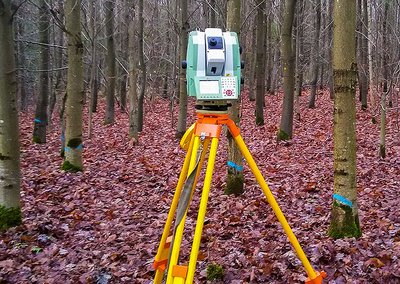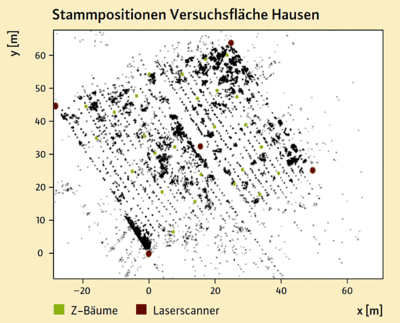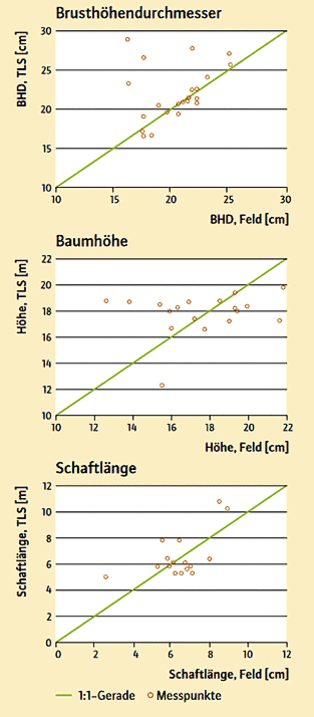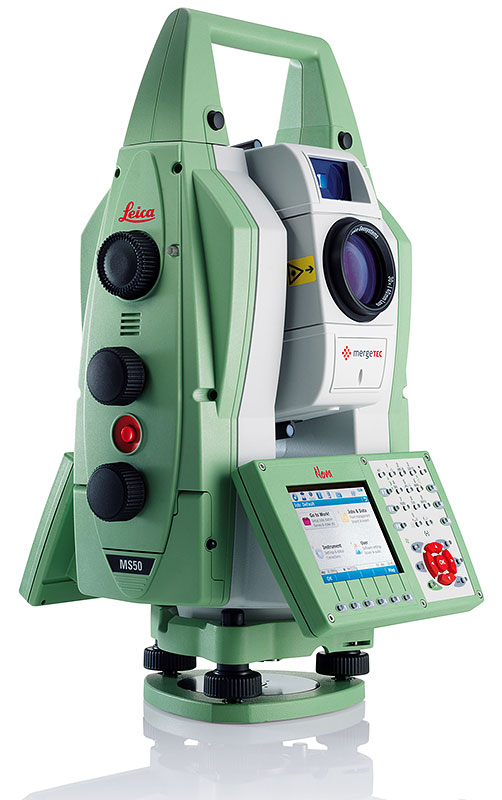Due to the changing climatic conditions the importance of the sweet chestnut (Castanea sativa) will become ever more relevant in the future. Till now, however, there has not been much experience with its cultivation in Bavaria. As a result, the Bavarian State Institute of Forestry (LWF) has started to permanently observe stands of sweet chestnut in the Municipality of Hausen (county of Würzburg). Thorough growth and yield observations were made on the oldest subareas. In addition, these areas were cataloged with the help of a terrestrial laser scanner (TLS). Figure 1 gives an impression of the approximately 55 x 45 meter large observation area and shows the laser scanner.
TLS on the LWF
In addition to the established methods of cataloging the site, the permanent observation areas of the LWF are also scanned with a Leica MS 50 which is a tachymeter laser scanner combination device (Fig. 1). It is also a goal to scan new areas either once or multiple times within the framework of research projects and determine the site coordinates with GNSS (Global Navigation Satellite System) with high-precision.
Observation: five points
The observation area was scanned in the spring of 2016. The device was positioned at five locations inside of the observation area: a 360° wraparound scan (dome-scan) from the interior skidding trail plus four 90° corner scans with a respective resolution of 0,75 Million were conducted. Additionally, before the scanning on the skidding trail commenced a high resolution panorama photo from 480 single images was generated.
It should be investigated whether a semi-automated determination of branch free boles in a young and comparatively dense hardwood stand is possible. This is because the boles free of branches are both silviculturally significant (used as a measure for controlling the timing of forest operations) and of particular importance for utilization (optimization of the amount to be harvested). In total the twenty-six crop trees (=100 crop trees / ha) of the stand were examined
In a virtual cut through the scanning data approx. two meters above the soil surface (Fig. 2) the distribution of the crop trees and the position of the laser scanner can be seen.
Analysis: Crop trees
Figure 3 shows the key parameters of the stand. The branchless boles were evaluated on the quality of circular alignments on virtual cuts along the stem axis. Before the evaluation routine of the application could be implemented every single tree had to be manually differentiated (segmentation). which thus limited the scope of the investigation. Only the data for the twenty-six crop trees were analyzed.
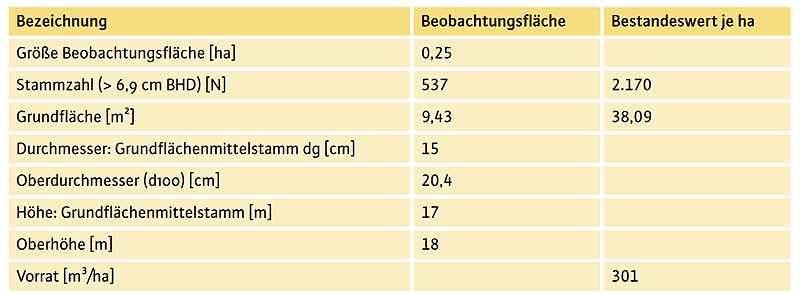
Fig. 3: Dentrometric values of the observation areas and the twenty-one year old sweet chestnut stand in the fall of 2015 (changed according to Fricker 2016)
Results: no significant differences
The values of the TLS analysis were compared with the observations from the field. Figure four shows the results of the diameter at breast height (top), tree height (middle),and the branch free bole (bottom). The 1:1 line in the figure shows where the values would be if the observed values in the field equaled those measured by the laser scanner.
The average diameter at breast height (DBH) from the TLS data was approximately 1.6 centimeters above those from the field measurements. The values for height are on average about twenty centimeters above those measured in the field. The values for the branch free boles from the TLS data and the field observations are only about ten centimeters apart from one another.
Analysis' did not show any significant difference between the benchmark values. One can see from the figures that the single trees of the respective parameters sometimes display substantial variation.
Evaluation of the results
The good results of the field and TLS measurements is pleasing. The TLS technology is also fundamentally capable to automatically (and semi-automatically) deliver parameters relevant to forest inventory. This is only possible with a high level of labor and a high degree of computer knowledge is also necessary. The primary problem is that to date no satisfactory approach for the differentiation (segmentation) of the 3D point clouds on a forest level into data for single trees exist.
For the extracted data of the single trees it can be shown that these were only partially obtained (one sided and/or only a few data points on the surface). As a result, the values for DBH could only be estimated based on help from comparatively robust circular alignments. The strength of the TLS system can be seen in the good agreement of the height measurements which are simply and quickly obtained. Additionally, a very good estimation of the average length of the branch free bole is possible with this technology. On a single tree basis the results were not satisfactory.
Prospects
The LWF continues to work on the further development of the technology for the forestry praxis. This is because the silvicultural practices will become more variable and fortunately the mixture and canopy layers are increasing. This requires remote sensing technologies that can satisfy the needs of various silvicultural forms. TLS can, for the most part, remedy the deficiencies and weaknesses of the classical forest inventory. The medium-term goal is the development of a modular software solution. For every single modular element a description and demonstration for every suitable forest situation shall be provided as well as which results should be utilized.

